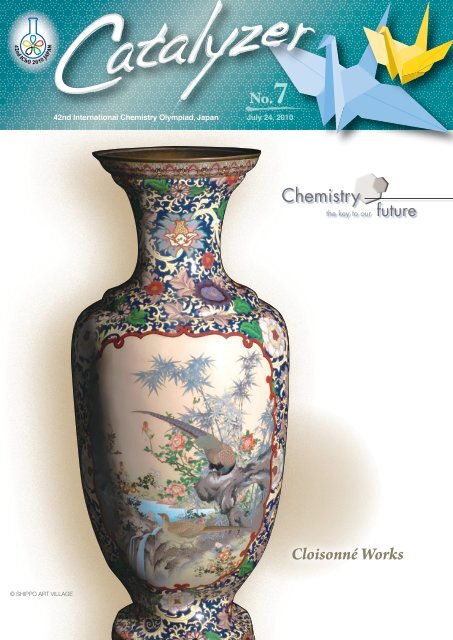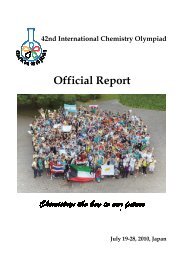Cloisonné Works - 42nd International Chemistry Olympiad
Cloisonné Works - 42nd International Chemistry Olympiad
Cloisonné Works - 42nd International Chemistry Olympiad
You also want an ePaper? Increase the reach of your titles
YUMPU automatically turns print PDFs into web optimized ePapers that Google loves.
<strong>Chemistry</strong>the key to our futureCloisonné <strong>Works</strong>© SHIPPO ART VILLAGE
七 宝 焼Shippo-yakiCloisonné <strong>Works</strong>A cloisonné is a piece created with a technique todecorate metalwork made from gold, silver, copperetc. The metal basis is colored with fine glassypowder, and then heated in a kiln for the glaze to fix.In Japanese such technique as well as the piecescreated using it is called “Shippo-yaki.” The wordShippo originally came from Buddhist terms meaning“seven precious things”, namely, gold, silver, lapislazuli, shells of giantclams (shako), agate,pearls and iye (a kindof agate producedin China). The nameShippo-yaki was givenas the cloisonné pieceShaping a metal basisso created was thoughtto be as beautiful asthe Shippo.The technique wasoriginally inventedin the region aroundMiddle East, andcloisonné pieces arefound from excavated ancient Egyptian ruins: it isbelieved to have been brought to Japan between3rd and 7th centuries via China. In 19th century,numerous craftworks and decorative articles ofdefinite Japanese style were produced using thistechnique.The glazing used in Shippo-yaki is mainly composedof SiO2, Pb3O4, KNO3, Na2CO3, etc, and transitionmetal compounds such as cobalt oxide, iron oxides,and manganese dioxide are added. Heated up totemperature of around 800 °C on the metallic base,the glazing melts to show glassy color, dependingon which kinds of metals are contained (e.g., red forgold, blue for copper oxide, indigo for cobalt oxide,purple for manganese dioxide, and brown for ironoxide). A Shippo-yaki piece is completed by paintingelaborate patterns and motifs on the base withvarious glazing and fusing in kilns.Because the process is relatively simple, somehandicraft shops and Shippo-yaki shops in Japanoffer cloisonné-making experience programs. Ifyou come across one of those, why don’t you giveit a try?Decorating with glazingBlu-rayBlu-ray disc is an optical disc storage that uses blue-violet laser to write andrewrite data on the disc. While in case of CD and DVD red laser that has awavelength of 650 nm is used, the blue violet laser used for Blu-ray has awavelength of 405 nm; this makes it possible to reduce the radius of beam spot,allowing significantly more data to be stored on a single disc compared to DVDs:the capacity is as high as 25 GB per single-layer disc and 50 GB per dual layereddisc. This made it possible not only to enjoy a full high definition movie at home,but also to add interactive functions, and even connection to internet. Usage ascompletely new types of media is still actively sought for. The blu-ray may holdenormous potentialities to provide brand new visual experience, improving andinnovating existing ways of entertainment.
Practical ExamPHOTO REPORTThe 5-hour practical exam session was held at Waseda University Nishiwaseda Campusfrom 1 pm to 6 pm of July 22.<strong>42nd</strong> <strong>International</strong> <strong>Chemistry</strong> <strong>Olympiad</strong>How was the practical exam?Stephen Haniel Yuwono, IndonesiaIt's not like what I was expecting,but I can do it well enough.It's tiring actually, but it'salways amusing to see thebeauty of chemicalsubstances' colors.Gonçalo Vitorino Bonifácio, PortugalI really don’t know. I wasn’t really sure ofmost of the answers, but I hope I wasn’t thatwrong. Now the hopes are on the theoreticalexam. Good luck to everyone.Luciano Barluzzi, ItalyI think good!!Hanieh Safari, IranI now feel comfortable.It's important that it finished.
Program, July 24 [sat.]StudentsMentors and Scientific Observers7:00- Breakfast 7:00- Breakfast8:00- Transfer to Univ. Tokyo 8:00- Excursion (Kamakura)9:00- Theoretical Exam14:30- Lunch16:30- Transfer to Yokohama19:00- Reunion Party 19:00- Reunion Party21:00- Transfer to NYC 21:00- Transfer to OVTAWEATHER NEWSTokyooccasionally cloudyhighlow34 ºC93 F26 ºC79 FChibaoccasionally cloudyhighlow33 ºC91 F24 ºC75 FAs of July 23Hope for IChOUruguayTo meet new people from other culturesand do our best for the competition.Stereochemistry with ORIGAMI 3Regular octhedron from four rectangularsheets of origami paper.A stable regular octahedron (b) can be obtained by assembling four units of the samechirality as in (a). In other words, (b) can be obtained from 4R or 4L (See No.3 or 5),where R and L, respectively, stand for the right- and left-handed units.A regular octahedron can also be obtained from 2R+2L.By using either, 3R, 3L, 2R+1L, or 1R+2L, one can construct a trigonal bipyramid (c).By using either combination of 5-0, 4-1, or 3-2, one can construct a pentagonal bipyramid(d).Many other polyhedra, such as an icosahedron (5R+5L), and evena soccer ball (football) (45R+45L!!) can be constructed from these units. SwitzerlandMaking new friends from all around theworld and keep improving our performance.MalaysiaTo learn more about chemistry for everythingaround us involves chemistry. After all,chemistry is “the key for our future”!Message frompast participantZahariev IvanBulgaria, participated in 31st and 32nd IChOI wish you a good luck and success in the olympiccompetition!!! Try to do your best, I am sure all of you will!!!Don't feel disappointed if some problems are not solved so welland if your results are not the ones you have dreamed for!!!You are country representatives, great people! Rememberthe Olympic principle that the participation in IChO is themost prestigious thing in the World! Try to create as manyfriends as possible here in Tokyo, try to get to know Japanand its wonderful culture! Let us enjoy <strong>42nd</strong><strong>International</strong> <strong>Chemistry</strong> <strong>Olympiad</strong> together!!!<strong>42nd</strong> <strong>International</strong> <strong>Chemistry</strong> <strong>Olympiad</strong>Editor-in-chief : Haruo HosoyaEditors : Shigeru Machida, Atsunori Mori, Hiroshi Seta,Daisuke Takeuchi, Akiko Utagawa, Yuki YamasakiTranslator : Maiko Katayama Designer : Keiko TaharaContact: <strong>42nd</strong> IChO Office1-5 Kanda-Surugadai, Chiyoda-ku, Tokyo 101-0062, JapanE-mail: contact@icho2010.orgWebsite: http://www.icho2010.org/( "Today's photo" is available on this site.)



